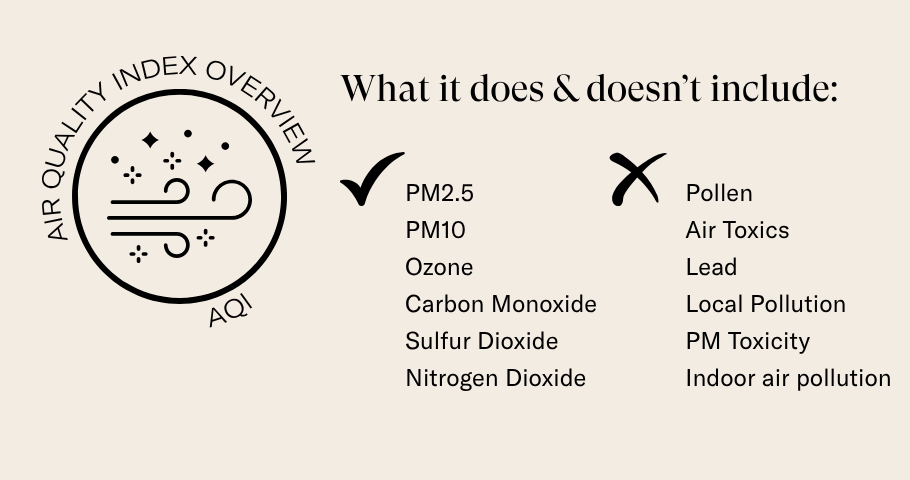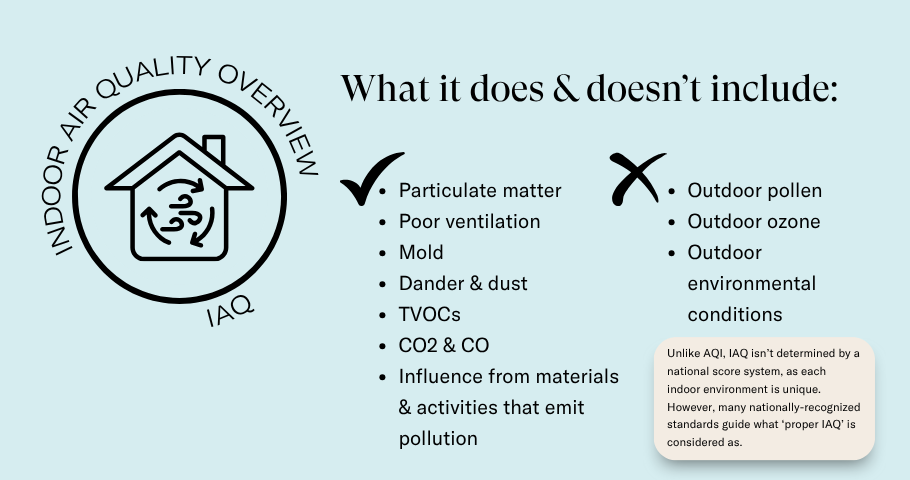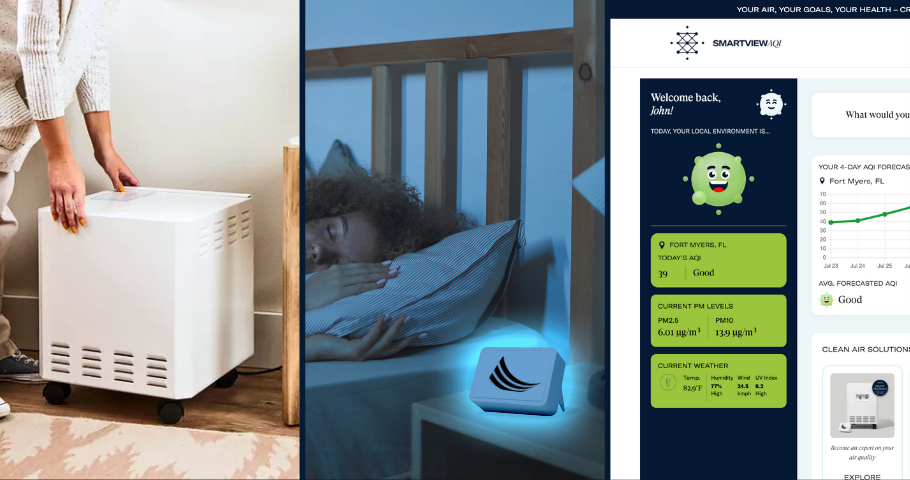Understanding the Difference Between AQI vs IAQ and Why Both Matter – 5 Tips to Protect from Both
As conversations about environmental wellness grow louder, many people are beginning to track their air quality. But there’s often confusion around two commonly used terms: AQI (Air Quality Index) and IAQ (Indoor Air Quality). Understanding the differences between them—and why both matter—is essential to maintaining a healthy environment at home and beyond.
In this guide, we’ll explain AQI vs IAQ, clarify how they’re measured, and show you how to take action with tools like sensor technology, medical-grade air purifiers, and smart monitoring systems.
What Is AQI?
The Air Quality Index (AQI) is a standardized system developed by the Environmental Protection Agency (EPA) to report on the cleanliness of the outdoor air. It measures air pollutants such as:
- Ground-level ozone
- Particulate matter (PM2.5 and PM10)
- Carbon monoxide
- Sulfur dioxide
- Nitrogen dioxide

These air pollutants can come from traffic emissions, industrial plants, wildfires, and even natural sources like dust storms. Ground-level ozone, in particular, is formed when sunlight reacts with pollutants from vehicles and factories—making it especially common on hot, sunny days in urban areas. The AQI ranges from 0 to 500, with higher numbers indicating worse air quality and a greater risk of health effects, particularly for sensitive groups such as children, seniors, and people with respiratory issues. These sensitive groups, in particular, are especially affected by outdoor air pollution.
You can track local AQI data from trusted sources like AirNow.gov or view it in real time through the SMARTView AQI dashboard, which pulls live sensor data from your region.
The AirNow’s Air Quality Index basics page offers a helpful breakdown of how the AQI is calculated and what each level means for your health.
What Is IAQ?
Indoor Air Quality (IAQ) refers to the air inside buildings—your home, office, or school. While AQI is governed by outdoor factors, IAQ is influenced by things like:
- Poor ventilation
- Indoor activities (cooking, cleaning)
- Indoor air pollution from building materials and furniture
- Mold, pet dander, and particulate matter
- Volatile Organic Compounds (VOCs) and other chemical emissions
Poor indoor air quality can cause a range of health effects—from headaches, allergies, and fatigue to chronic respiratory conditions and long-term lung damage. Elevated carbon dioxide levels, in particular, can lead to cognitive sluggishness, poor concentration, and sleep disruption—making indoor air quality management critical for daily well-being.
For more on common sources and solutions, the EPA’s Indoor Air Quality guide is a trusted resource for understanding how building materials, furnishings, and household activities impact IAQ.

Why AQI and IAQ Aren’t the Same—But Are Both Essential
It’s a common assumption that good AQI means your indoor air is clean too—but this isn’t always the case. For example, even on a day when outdoor air quality is rated “Good,” your home’s IAQ could suffer from indoor air pollution caused by everyday activities like cooking with gas, using chemical cleaners, or introducing new furniture that emits VOCs.
Conversely, when AQI is “Unhealthy” due to wildfire smoke, smog, or pollen, your indoor air can still be protected if your space is well-sealed and you’re using a medical-grade air purifier or advanced HVAC filters.
In short:
- AQI reflects outdoor environmental conditions, and is mostly out of your control.
- IAQ is specific to your indoor space—and with the right tools, you can take charge of it.
Understanding both AQI vs IAQ gives you a more complete picture of your personal air quality exposure, especially when it comes to avoiding the health effects of air pollution and particulate matter.
The Key Differences
| Feature | AQI | IAQ |
|---|---|---|
| Location | Outdoor ambient air | Indoor air (homes, offices, schools, etc.) |
| Measured by | EPA and local government sensors | In-home sensor data (like IAQ monitoring systems) |
| Common pollutants | Ozone, PM2.5, carbon monoxide, nitrogen dioxide, sulfur dioxide | VOCs, dust, mold, pet dander, carbon dioxide, particulate matter |
| Visibility | Publicly available on sites like airnow.gov | Private via personal IAQ devices and management systems like SMARTView AQI |
| Impact | Tells you if outdoor conditions are safe | Tells you how healthy your indoor air is |
Understanding both gives you a full picture of the air quality in and around your space.
Sensor Data Makes the Difference
Both AQI and IAQ rely on accurate sensor data to help you understand your air quality exposure. With smart devices like the EnviroKlenz SMART IAQ Sensor, you can track multiple indoor pollutants in real time, including:
- Volatile Organic Compounds (VOCs)
- Carbon dioxide (CO₂)
- Particulate matter (PM2.5)
- Temperature and humidity (which can affect mold growth)
Over time, these insights help you reduce indoor air pollution inside your home for improved indoor air quality and minimize the health effects of ongoing exposure. Tracking pollutant levels also helps you spot patterns in your daily habits that may be contributing to indoor air pollution, such as poor ventilation or frequent use of chemical-based products.
The Health Effects of Poor Air Quality
Whether inside or outside, poor air quality can have significant short- and long-term health effects. These include:
- Short-term: coughing, shortness of breath, irritation of the eyes, nose, or throat
- Long-term: asthma, heart disease, chronic respiratory illnesses, and even neurological conditions
Children, the elderly, and immunocompromised individuals are particularly vulnerable. By understanding AQI vs IAQ, you can reduce the burden on your body and create an environment that supports clean air and well-being—especially with the help of reliable air purifiers that remove harmful contaminants from your space.
According to the World Health Organization (WHO), exposure to both indoor and outdoor air pollution is linked to millions of premature deaths worldwide each year—highlighting the urgent need to monitor and improve air quality.
How to Improve Both AQI and IAQ
While you can’t change your area’s Air Quality Index, you can certainly reduce its impact—and take control of your indoor air quality:
1. Monitor AQI vs. IAQ Daily
Track both indoor and outdoor conditions using the SMARTView AQI dashboard alongside the SMART IAQ Sensor to track indoor and outdoor air quality from one place. You’ll get real-time alerts about air pollution events and rising levels of indoor air pollutants.
The CDC’s guide to air quality and health provides helpful tips on how to respond to poor outdoor air conditions—especially for vulnerable populations like children, older adults, and people with asthma.
2. Use Medical-Grade Air Purifiers
Top-tier air purifiers like the EnviroKlenz Air System Plus use advanced filtration and UV-C technology to eliminate pollutants like VOCs, mold spores, bacteria, and fine particulate matter.
3. Maintain HVAC Systems
Your HVAC system plays a key role in filtering indoor air pollutants. Ensure your system is running optimally with regular maintenance and upgrade to HEPA filters or SMART filters that capture ultra-fine particles. EnviroKlenz offers HVAC filters engineered for superior air quality performance.
4. Control Pollution at the Source
- Avoid using aerosol sprays or strong chemical cleaners.
- Choose low-VOC products for paints and furnishings.
- Regularly clean to manage pet dander and dust buildup.
- Use exhaust fans when cooking or showering.
5. Seal and Ventilate Strategically
- When there is wildfire smoke or high AQI days, seal windows and doors to prevent outdoor air pollution from entering.
- On good AQI days, ventilate by opening windows to allow clean air to circulate and reduce indoor pollutants like CO₂.

The Role of Smart Tools in Air Quality Management
Technology plays a powerful role in maintaining a healthy home environment. By combining smart IAQ monitors, automated air purifiers, and easy-to-use dashboards, you can:
- See trends in your home’s air quality
- Get maintenance reminders (like replacing your HEPA filter)
- Receive alerts when pollutant levels rise
- Make changes instantly from your phone or tablet
Products like the EnviroKlenz SMART IAQ Sensor and Air System empower homeowners to stay ahead of indoor air quality issues—providing real-time insights and automatic adjustments to keep your air clean, healthy, and hassle-free.
Let me know if you want this to emphasize a different product feature, like alerts, data tracking, or health protection.
Live healthier when measuring AQI & IAQ together
Whether you’re preparing for wildfire season, living in a high-traffic urban area, or just want to breathe cleaner at home, knowing the difference between AQI vs IAQ puts you in control of your environment.
By using sensor data, adopting smart air tools, and staying vigilant about indoor air pollution, you can limit your exposure to airborne toxins, reduce health effects, and enjoy the lasting benefits of clean air.
As air pollution events rise due to climate change and urbanization, protecting your indoor space is more important than ever. Start with awareness. Follow with action.
Stay informed. Stay protected. Breathe easier—with tools from EnviroKlenz.
